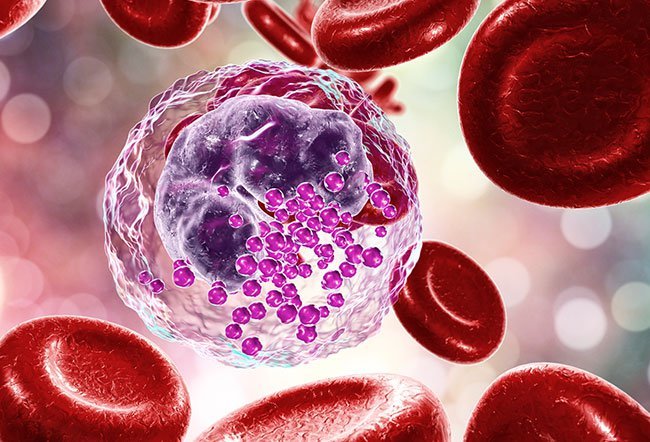What Is the Function of Basophils?
What are basophils?

Basophils are a type of white blood cell (leukocyte), which constitutes one of the components of the immune system. Along with other white cells, basophils play an important role in fighting bacterial, fungal, and viral infections.
Like all blood cells, basophils also originate as stem cells in the bone marrow and develop into basophils in a process known as hematopoiesis. The bone marrow releases mature basophils into the bloodstream where they circulate for a few days and die, to be replaced by new basophils.
Basophils are part of the innate immune system, which means they do not recognize pathogens they are exposed to, but attack all organisms they perceive as foreign to the body. Basophils are known as granulocytes because they contain small granules which store and release several enzymes which help fight infection.
Determining the basophil count in the blood helps in the diagnosis of several blood-related conditions, and the presence of inflammation. A diagnostic test known as the basophil activation test (BAT) is highly accurate in identifying food, drug, or toxin allergies.
What is the function of basophils?
Though basophils constitute a minuscule percentage of white cells, they play an important role in the immune responses to infectious bacteria and parasites. Following are the main functions of basophils:
- Recognize foreign organisms that invade the body.
- Directly destroy and engulf foreign organisms in a process known as phagocytosis.
- Release an enzyme known as histamine which dilates the blood vessels around the injection site, which
- Improves blood flow and promotes healing
- Provides other immune cells better access to the infection site
- Release histamine in response to allergens, and bind with an antibody known as immunoglobulin E (IgE) to protect the body against allergens. Histamine is the cause of allergic reactions such as itchy skin, hives, runny nose, and watering eyes.
- Release an enzyme known as heparin which prevents blood clotting at the injection site.
What are normal and high basophil ranges?
The normal range of absolute basophil count is 0 to 300 microliters. Basophils normally constitute just 0.5% to 1% of the total white blood cell (WBC) count. The absolute basophil count is derived by taking the total white cells count and calculating the percentage of basophils in them.
Abnormal basophil levels can be detected with a complete blood count (CBC) test, which evaluates the composition of all blood cells. Symptoms of abnormal basophil levels depend on the underlying conditions. Abnormal basophil levels may be corrected by treating the underlying conditions.
What is considered a high basophil count?
A basophil count is considered high (basophilia) if the absolute basophil count is above 200 microliters or the percentage is greater than 2%. The absolute count range considered normal may vary to some extent in laboratories in different places, based on the local population.
What are the causes of basophilia?
Basophilia can be caused by many conditions such as the following:
- Hypothyroidism: Underactive thyroid
- Myeloproliferative disorders: Abnormal growth of a single type of blood cell in the bone marrow such as:
- Chronic myelogenous leukemia: Overgrowth of white cells
- Polycythemia vera: Overgrowth of red cells
- Primary myelofibrosis: A rare bone marrow cancer in which fibrous scar tissue replaces the soft spongy tissue
- Essential thrombocythemia: Overgrowth of platelets
- Chronic neutrophilic leukemia: Overgrowth of neutrophils
- Chronic eosinophilic leukemia: Overgrowth of eosinophils
- Chronic basophilic leukemia: Overgrowth of basophils
- Systemic mastocytosis: Buildup of mast cells in organs such as spleen, liver, bone marrow, and intestines
- Hypereosinophilic syndrome: Persistently elevated eosinophil count for more than six months with no identifiable reason, which can affect the heart, bone marrow, or the nervous system
- Chronic inflammation
- Inflammatory autoimmune diseases such as rheumatoid arthritis
- Infectious diseases such as:
- Transplant organ rejection
What does it mean when basophils are low?
Low basophil count is known as basopenia, which can occur from the following conditions:
- Hyperthyroidism (overactive thyroid)
- Acute inflammation and infection, because the basophils are not visible in blood tests after they release the enzymes to fight the infection
- Acute allergic reactions such as:
- Hives and itchy skin
- Runny nose
- Watery eyes
- Sneezing
- The anaphylactic allergic reaction is a life-threatening condition that can cause severe symptoms that include:
- Difficulty breathing
- Low blood pressure
- Lightheadedness
- Vomiting
- Swelling in the throat, tongue or face
- Rapid heart rate
- Chest tightness
